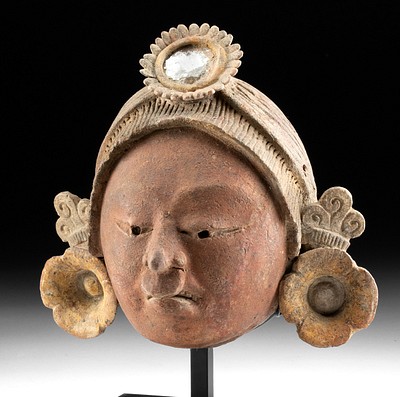Chinese Tang Pottery Lokapala w/ Sancai Glaze, TL'd
Lot 77
About Seller
Artemis Fine Arts
686 S Taylor Ave, Ste 106
Louisville, CO 80027
United States
Selling antiquities, ancient and ethnographic art online since 1993, Artemis Gallery specializes in Classical Antiquities (Egyptian, Greek, Roman, Near Eastern), Asian, Pre-Columbian, African / Tribal / Oceanographic art. Our extensive inventory includes pottery, stone, metal, wood, glass and textil...Read more
Estimate:
$3,000 - $4,500
Absentee vs Live bid
Two ways to bid:
- Leave a max absentee bid and the platform will bid on your behalf up to your maximum bid during the live auction.
- Bid live during the auction and your bids will be submitted real-time to the auctioneer.
Bid Increments
| Price | Bid Increment |
|---|---|
| $0 | $25 |
| $300 | $50 |
| $1,000 | $100 |
| $2,000 | $250 |
| $5,000 | $500 |
| $10,000 | $1,000 |
| $20,000 | $2,500 |
| $50,000 | $5,000 |
| $100,000 | $10,000 |
| $200,000 | $20,000 |
About Auction
By Artemis Fine Arts
Jul 14, 2022
Set Reminder
2022-07-14 10:00:00
2022-07-14 10:00:00
America/New_York
Bidsquare
Bidsquare : Exceptional Antiquities Ethnographica Fine Art
https://www.bidsquare.com/auctions/artemis-gallery/exceptional-antiquities-ethnographica-fine-art-9692
Museum-worthy examples of classical antiquities (Egyptian, Greek, Roman, Near Eastern), Viking, Far East / Asian, Pre-Columbian, African / Tribal, Oceanic, Native American, Spanish Colonial, Fossils, Ancient Jewelry, Fine / Visual Arts, so much more! Artemis Fine Arts info@artemisfinearts.com
Museum-worthy examples of classical antiquities (Egyptian, Greek, Roman, Near Eastern), Viking, Far East / Asian, Pre-Columbian, African / Tribal, Oceanic, Native American, Spanish Colonial, Fossils, Ancient Jewelry, Fine / Visual Arts, so much more! Artemis Fine Arts info@artemisfinearts.com
- Lot Description
East Asia, China, Tang Dynasty, ca. 618 to 907 CE. A fantastical mold-formed pottery guardian figure known as a lokapala with a serious expression wearing elaborate armor and robes as he stands triumphantly on a recumbent ox, all adorned in vibrant sancai glazes of marigold and emerald hues. He is adorned in greaves and a split tunic skirt with billowing back panel and flared sleeves on his arms. He places his left hand on his hip, bending the arm at the elbow, as he holds up his right hand, which is clenched in a fist, likely to have previously held a weapon such as a sword. Turning slightly right, his helmeted head exhibits painted features with beady eyes beneath narrowed brows, a broad nose, high cheekbones, and fleshy lips enveloped by liberal remains of a sweeping moustache and a short goatee. Size: 7.9" W x 16.8" H (20.1 cm x 42.7 cm)
Lokapalas were demonic guardians from Buddhist tradition that were believed to protect the deceased, and often grouped in a collection of 4 tomb figures composed of a pair of lokapalas and a pair of civil officials to represent each of the cardinal directions. These figures were one of the few Buddhist themes depicted in Chinese funerary iconography. The faces of these lokapala are often painted to look like foreigners to represent the cultural exchange and spread of Buddhism from other parts of Asia. This may be Virupaksha, Guardian King of the West, both fearsome and wrathful- trampling the ox underfoot as a sign of his might.
The Tang Dynasty was a thrilling time in Chinese history, when trade flourished along the Silk Routes and unified China was the richest country on earth. Chang'an (now Xi'an) was the Tang capital, and it was one of the most cosmopolitan cities on earth, filled with foreigners who had travelled to China to trade; the influence of foreigners and talented native Chinese, combined with the economic prosperity brought on by trade and the new religion from India, Buddhism, created a powerful cultural milieu where poetry and other forms of art flourished. This figure exemplifies the foreign influences on the Tang Dynasty as it corresponds to Buddhist warrior deities that assume a mortuary role in China but also serve as protectors of Buddhist temples, known as "Protector of the Burial Vault" or "Protector of the Burial Ground."
This piece has been tested using thermoluminescence (TL) analysis and has been found to be ancient and of the period stated. A full printed and bound report is available to the buyer upon request.
Provenance: ex-Barakat Gallery, Beverly Hills, California, USA, acquired prior to 2000
All items legal to buy/sell under U.S. Statute covering cultural patrimony Code 2600, CHAPTER 14, and are guaranteed to be as described or your money back.
A Certificate of Authenticity will accompany all winning bids.
PLEASE NOTE: Due to recent increases of shipments being seized by Australian & German customs (even for items with pre-UNESCO provenance), we will no longer ship most antiquities and ancient Chinese art to Australia & Germany. For categories of items that are acceptable to ship to Australia or Germany, please contact us directly or work with your local customs brokerage firm.
Display stands not described as included/custom in the item description are for photography purposes only and will not be included with the item upon shipping.
#170933Professionally repaired with light restoration. Expected surface wear with light abrasion and some minor nicks. Otherwise, excellent with impressive remining pigments and detail. TL holes to proper left underside of base and verso of figure's neck.Condition
- Shipping Info
-
All shipping is handled in-house for your convenience. Your invoice from Artemis Gallery will include shipping calculation instructions. If in doubt, please inquire BEFORE bidding for estimated shipping costs for individual items.
-
- Buyer's Premium



 EUR
EUR CAD
CAD AUD
AUD GBP
GBP MXN
MXN HKD
HKD CNY
CNY MYR
MYR SEK
SEK SGD
SGD CHF
CHF THB
THB














